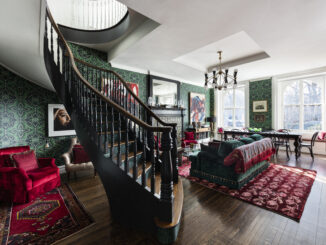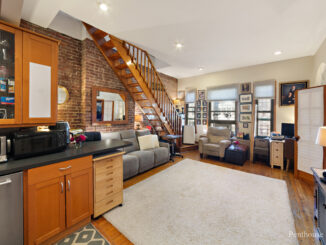
Frank Sinatra and actress Mia Farrow — who had one of the most improbable marriages in Hollywood and show business history — once called this Upper East Side brownstone their home.
Now, the landmarked residence that the famed couple shared has hit the market for the first time in more than 50 years — for $4.45 million.
Built in 1872, the historic home at 249 E. 61st St., between Second and Third avenues, is where Sinatra resided from 1963 to 1969 — before, during and after his brief marriage to Farrow.
The couple met on a studio set in 1964 when Sinatra was 49 and Farrow was 19. They married two years later, in Vegas, when Farrow turned 21. It was her first marriage and his fourth; they divorced two years later.
Even after the split, Sinatra wanted to stay in the home.
“He didn’t want to move out, but he wanted to build a garage and he wasn’t allowed to,” said Teimour Solomon, whose late parents, Dr. David Y. Solomon and Yris Rabenou Solomon, bought the home from Sinatra in 1969 and raised their two children there — Darius, born in 1968, and Teimour, born in 1972.
Teimour’s family escaped antisemitism — his mother fled Nazi-occupied France while his Iraqi-born father fled persecution, first in Iraq and then in Iran. The Upper East Side property later became a refuge for friends and family who fled the Islamic Revolution in Iran in 1979.
“This place, and the story of the house, is a classic American story. My family were always chased out of their homes — in France, Iraq and Iran — and they came to the US to live in freedom,” Teimour said. “Then they opened the doors here for others who were fleeing persecution.”
At 16 feet wide, the 3,730-square-foot home comes with four bedrooms and 4½ baths — and an additional 933 square feet below ground.
The residence is now part of the Treadwell Farm Historic District. Its history also includes a 19th-century renter who offered to exchange all of the dwelling’s contents — including furniture, mirrors, carpets and pianos — for Bourbon whiskey, according to reports.
By 1919, the architect Frederick Sterner redid the house, removing the stoop and adding a lower-level entrance and terra cotta to the exterior.
Sinatra later removed moldings to give the home a sleeker, more modern look, Teimour said. However, original details, such as hardwood floors, stained glass and a fireplace, remain. The Solomon family also added French doors and opened up the rear to add light from the garden.
Teimour’s father was the first Jew to be admitted to the Royal College of Medicine in Baghdad. But he had to flee to Iran to practice medicine, after narrowly missing a roundup of Jews who were hanged. He ultimately moved to New York, where he accepted a fellowship at the Albert Einstein College of Medicine, which is part of Montefiore Hospital, in 1961, Teimour said.
Meanwhile, Teimour’s mother — the daughter of a Persian Jew and a German convert to Judaism — fled France for the United States. She became a singer who recorded French folk music for Columbia Records.
When Sinatra did not appear at the brownstone closing, Yris wanted to speak to him from the proceeding to make sure he approved the sale. So his lawyer called him up. Yris spoke to Sinatra on the phone, but was still not convinced it was him. So she asked Sinatra to sing for her. And he did, Teimour said.
After her father died, Yris also joined her mother in the family business as an art dealer in ancient Persian and Middle Eastern art, and the brownstone reflected her career choice, as it was filled with museum-quality works.
“There was everything, from Russian icons to ancient Mesopotamian pieces, Egyptian columns and 20th-century modern art,” Teimour said.
The home became a haven for immigrants of all races, ethnicities and socioeconomic backgrounds, said Teimour, adding that his father’s medical practice was nearby, on East 79th Street.
“He worked until his 90s, and he treated everyone from the Senegalese ambassador to the United Nations, to other high-ranking diplomats, to cab drivers — and then he’d invite them to our home for dinner,” Teimour said. He added that Friday night dinners were always open and often filled with 20 to 50 people.
The listing brokers are Thomas Wexler and Jed Garfield of Leslie J. Garfield.
Real Estate – Latest NYC, US & Celebrity News | New York Post



